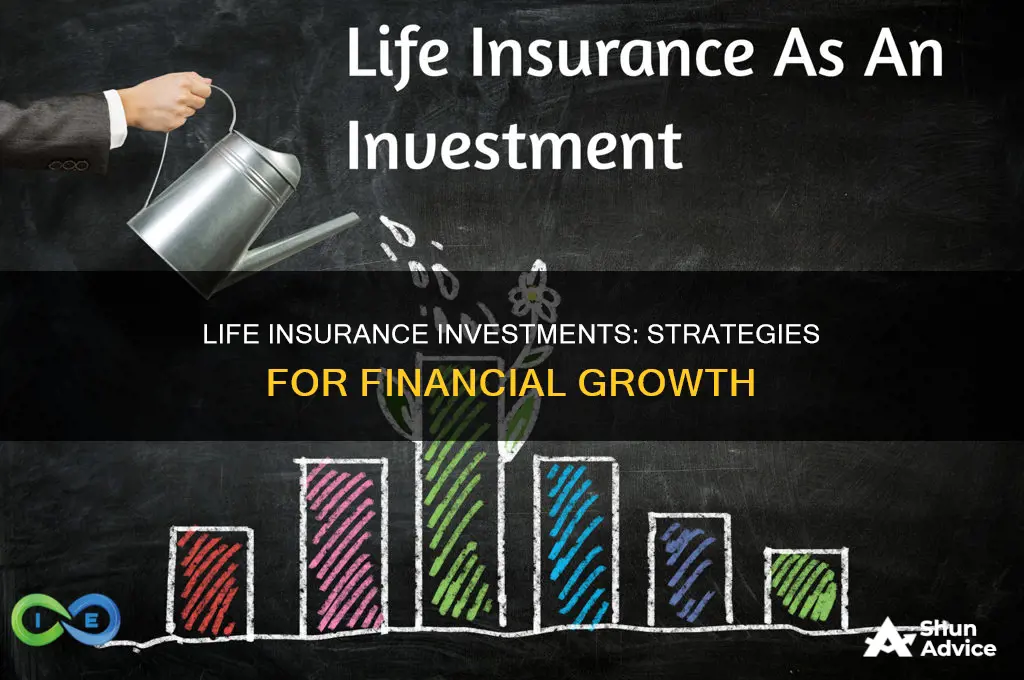
Life insurance is typically purchased to provide financial security for loved ones after the policyholder's death. However, some life insurance policies can also be used as an investment tool during the policyholder's lifetime. This is achieved through the accumulation of cash value, which can be accessed in several ways, including loans, withdrawals, and income supplements.
There are two main types of permanent life insurance that can be used as an investment: whole life insurance and universal life insurance. Whole life insurance is the most common type, offering a fixed premium, a guaranteed death benefit, and a savings-style cash value account with a guaranteed rate of return. Universal life insurance, on the other hand, offers more flexibility, allowing adjustments to premiums, death benefits, and cash value.
While life insurance can provide diversification and risk management benefits to an investment portfolio, it also has its drawbacks. These include potentially high fees and charges, low returns compared to traditional investments, and limited flexibility in adjusting coverage.
Before investing in life insurance, it is essential to carefully consider your financial goals, conduct thorough research, and consult a financial professional to determine if this strategy aligns with your specific needs and risk tolerance.
| Characteristics | Values |
|---|---|
| Purpose | Provide financial security for loved ones after death |
| Investment opportunity | Yes, some life insurance policies can be used as a financial asset during the policyholder's life |
| Types of life insurance | Whole life insurance, universal life insurance, variable life insurance |
| Tax advantages | Cash value grows tax-deferred; death benefits are generally income-tax-free for beneficiaries |
| Access to cash value | Withdraw, take a loan, receive "accelerated benefits", or cash out the policy |
| Investment options | Mutual funds, exchange-traded funds (ETFs), sub-accounts similar to mutual funds, stocks, bonds, indexes |
| Diversification | Helps to spread financial risks across different types of investments |
| Risk management | Death benefit and tax-deferred advantages offer a unique form of risk management |
| Long-term financial goals | Can help secure long-term financial stability; the cash value component grows over time and could serve as another income stream during retirement |
| Fees and charges | Surrender charges, administrative costs, and premiums can affect the overall return on investment |
| Potential conflicts | Investing heavily in a life insurance policy might limit the ability to invest in other areas |
| Returns | Returns may be lower compared to traditional investments like equities or bonds |
| Medical exam | Most policies with an investment component require a medical exam |
What You'll Learn

Whole life insurance
How it Works
When it Makes Sense
- Maxed-out retirement accounts: If you've maxed out your tax-advantaged retirement accounts, whole life insurance can provide additional tax-deferred savings.
- Lifelong dependent: Whole life insurance is suitable if you have a lifelong dependent, such as a child with a disability, as it offers permanent coverage and financial stability.
- Estate taxes: The cash value component makes whole life insurance a form of "forced savings," helping your loved ones pay estate taxes without dipping into other accounts.
- Diversification: The guaranteed, stable returns of whole life insurance can complement your investment portfolio by providing diversification and reducing market risk.
Drawbacks
However, there are also some drawbacks to consider:
- Expensive premiums: Whole life insurance premiums tend to be much higher than term life insurance, making it a costly option.
- Slow growth: It can take 10-15 years or longer for the cash value to grow sufficiently, making it a long-term commitment.
- Low rate of return: The average annual rate of return on the cash value is relatively low, typically between 1% to 3.5%.
- Limited control: You can't choose your investments, as the insurance company manages them, which may be unappealing to seasoned investors.
- Tax implications: Withdrawing or borrowing against the cash value may have tax consequences, and surrendering the policy can result in income tax on the gained value.
Cash in Your Investment Allocation: Wise or Unwise?
You may want to see also

Universal life insurance
Benefits of Universal Life Insurance Policies
- Flexible death benefit: You can increase or decrease the death benefit to fit your situation.
- Flexible premiums: You can choose how much you pay and when, which is helpful if your cash flow fluctuates.
- Cash value accumulation: The cash value component grows over time and can be used for various purposes, such as emergencies, home repairs, college tuition, or business investments.
- Tax advantages: The cash value grows tax-deferred, and the death benefit is paid income-tax-free to beneficiaries.
Drawbacks of Universal Life Insurance
- Fewer guarantees: Universal life insurance offers fewer guarantees compared to whole life insurance. The cash value growth and death benefit can be impacted by minimal premium payments.
- Potential lapse: If the net accumulated value of the policy is less than the monthly fees, the policy could lapse.
- Complexity: With more options than term or whole life coverage, universal life policies can be complex to manage.
- Potential tax consequences: Withdrawals from the cash value may be subject to taxes if they exceed a certain amount.
Who is Universal Life Insurance Suitable For?
Invest Wisely with Ally: A Beginner's Guide
You may want to see also

Variable universal life insurance
VUL is similar to variable life insurance, but it allows the policyholder to change their premium payment amount. While VUL insurance offers increased flexibility and growth potential compared to other life insurance options, the policyholder is exposed to market risk and could face substantial losses.
How VUL Works
VUL is a permanent life insurance policy that combines a death benefit with a savings component called cash value. This coverage can last the policyholder's entire life as long as they continue paying the insurance costs. A VUL lets the policyholder adjust how much they pay into the policy each year, similar to traditional universal life insurance.
The insurer will deduct the insurance costs from the premiums paid, and the remainder will go towards the policy's cash value. The policyholder can then invest the cash value in the market through various subaccounts, which may include stocks, bonds, money market securities, ETFs, and mutual funds.
Investment Risk and Cash Value
The growth of the cash value in a VUL policy is not guaranteed and is subject to market fluctuations. If the investments perform well, the cash value will grow more quickly, and the policyholder can access this value by taking a withdrawal or borrowing funds. However, if the investments perform poorly, the cash value may not grow as expected, and the policyholder could even lose money.
Pros and Cons of VUL
VUL gives the policyholder control over how to invest their cash value and allows them to pick subaccounts that align with their risk tolerance and investment objectives. VUL offers the potential for higher growth compared to other types of permanent life insurance. Additionally, the policyholder can adjust their premium payments to fit their budget.
However, VUL also carries risks and drawbacks. The return on the cash value is not guaranteed, and poor investment performance can result in slower growth or even losses. If the cash value is insufficient to cover the cost of insurance, the policyholder may need to increase their premium payments to maintain their coverage. VUL policies can also charge high fees due to the combination of life insurance and investment components.
Suitability of VUL
VUL may be suitable for individuals who want permanent life insurance protection, have a higher risk tolerance for investing, and prefer managing their investments. It could be an option for those who have maxed out their retirement accounts and are looking for additional tax-deferred investment growth. While VUL offers higher growth potential than other life insurance types, it is more complex and riskier, so careful consideration is necessary before purchasing this type of policy.
Healthcare News: Your Investment Guide
You may want to see also

Tax-free withdrawals
If you have a life insurance policy with a cash value component, you can generally access the money through withdrawals, loans, or by surrendering the policy and ending it. However, it's important to understand the tax implications of each option to avoid unnecessary taxes.
Withdrawing money from the cash value of your life insurance policy can be done tax-free, but only up to a certain limit. You can withdraw up to your basis in the policy tax-free. Your basis is the amount of premiums you have paid into the policy, minus any prior dividends paid or previous withdrawals. This is because you have already paid income tax on those dollars, so they won't be taxed again when you withdraw them.
However, if you withdraw more than your basis, the excess amount may be subject to income tax. This is because the cash value of your policy consists of your basis plus any earnings or investment gains, which grow tax-deferred while inside the policy. So, if you make a withdrawal over and above your basis, a portion of the withdrawal will be considered taxable income.
For example, if you have a cash value of $18,000 in your life insurance policy and your basis is $12,000, you can withdraw up to $12,000 tax-free. But if you withdraw $15,000, you will have to pay income tax on the additional $3,000.
It's important to note that there may be surrender charges or other fees associated with withdrawing from your policy, even if you only withdraw up to your basis. One way to avoid these charges is to take a policy loan from the insurance company, using the cash value in the policy as collateral. The amount you borrow is generally not treated as taxable income, as long as you repay the loan. However, you will have to pay interest on the loan, which is not tax-deductible.
Additionally, withdrawing money from your life insurance policy can have other consequences, such as reducing your death benefit or increasing your premiums. Therefore, it's important to carefully consider your options and consult with a financial professional before making any decisions.
Invest Cash Safely: Strategies for Secure Financial Growth
You may want to see also

Policy loans
One of the main advantages of policy loans is that they often have lower interest rates than personal loans, and the funds can be used for any purpose. Additionally, there is no formal approval process or credit check required, as you are borrowing against your own assets. The repayment terms are also flexible, with no set repayment schedule or date. However, it's important to keep in mind that if the loan isn't repaid before the policyholder's death, the insurance company will reduce the death benefit by the amount still owed.
When taking out a policy loan, the amount you can borrow is usually limited to a certain percentage of the policy's cash value, typically up to 90%. It's worth noting that the specific rules and requirements may vary depending on the insurance company.
While policy loans can provide easy access to cash, there are some potential downsides to consider. If the loan isn't repaid, the interest can accumulate and cut into the death benefit, potentially leaving beneficiaries with a reduced payout. Additionally, if the loan value exceeds the policy's cash value, the policy could lapse and be terminated by the insurance company, resulting in tax implications. Therefore, it's crucial to carefully consider the benefits and risks before taking out a policy loan and, if necessary, consult a financial advisor to understand how it fits into your long-term financial plan.
Untaxed Cash: Investing Strategies for Discretionary Funds
You may want to see also
Frequently asked questions
Life insurance can be a good investment tool, offering portfolio diversification, risk management benefits, and long-term financial stability. The cash value component grows over time and could serve as another income stream during retirement.
There are two main types of permanent life insurance that can be used as an investment: whole life insurance and universal life insurance. Whole life insurance is the most common type, offering a death benefit and a savings-style cash value account with a guaranteed rate of return. Universal life insurance offers more flexibility, allowing adjustments to premium payments and death benefits while accumulating cash value.
Life insurance can be used as an investment through its cash value component, which grows over time. Policyholders can borrow against or withdraw funds from this account while still alive, providing financial flexibility.
Investing in life insurance carries certain risks, including fees, low returns, and the need for a medical exam. The returns may be lower compared to other investment options, and the premiums tend to be higher for permanent policies.
To maximize your investment, consider diversifying your portfolio and managing risk. Permanent life insurance with a cash value component can help spread financial risks across different types of investments. Additionally, the death benefit and tax-deferred advantages provide a unique form of risk management.







